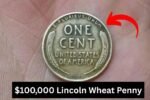Imagine finding a penny in your pocket worth $153,000! The Lincoln Wheat Penny, first minted in 1909, is a familiar sight in loose change, but some rare versions of this coin have collectors ready to pay big bucks. With its iconic wheat stalk design on the back, this penny is a piece of American history. Experts say a specific Lincoln Wheat Penny could fetch up to $153,000 at auction, and it might still be circulating. Let’s explore what makes this penny so valuable and how you can spot one.
A Penny with a Story
The Lincoln Wheat Penny was introduced to honor President Abraham Lincoln’s 100th birthday. It has Lincoln’s face on the front and two wheat stalks on the back, giving it the “Wheat Penny” nickname. Minted from 1909 to 1958, billions were made, so most are worth just one cent. But certain years, mint marks, or errors make some pennies stand out. These rare coins, especially from specific years like 1909 or 1943, can turn pocket change into a fortune.
What Makes It Worth $153,000?
The high value comes from rare errors or specific minting years. For example, the 1943 bronze Lincoln Wheat Penny is a legend—most 1943 pennies were made of zinc-coated steel due to World War II copper shortages, but a few bronze ones slipped through. These can sell for over $100,000, with top-condition coins hitting $153,000 or more. Other valuable versions include 1909-S VDB pennies (with the designer’s initials) or coins with double-die errors, where the design appears doubled. These quirks make collectors go wild.
| Feature | Details |
|---|---|
| Years to Check | 1909-S, 1943 bronze, 1955 double-die |
| Design | Lincoln portrait on obverse, wheat stalks on reverse |
| Common Value | 1 cent |
| Rare Value | Up to $153,000 for specific error coins or rare years |
| Key Errors to Look For | Bronze 1943, double-die, VDB initials |
How to Find a Rare Penny
Spotting a valuable Lincoln Wheat Penny takes a keen eye. Start by checking the date on the front—focus on 1909, 1943, or 1955. Look at the mint mark, a small letter below the date (“S” for San Francisco, “D” for Denver, or none for Philadelphia). For 1943 pennies, hold a magnet to the coin; if it doesn’t stick, it might be the rare bronze version. Double-die errors show blurry or doubled numbers or letters. If you think you’ve found a gem, visit a coin dealer or grading service like PCGS for a professional opinion.
Why Collectors Love These Pennies
Collectors are obsessed with Lincoln Wheat Pennies because they’re a snapshot of history. The rare 1943 bronze penny, for instance, is a mistake from a time when the U.S. was saving copper for the war effort. Social media, like posts on X, keeps the buzz alive, with collectors sharing photos of their finds and tips for spotting rarities. Even less valuable Wheat Pennies, like those in great condition or from low-mintage years, can sell for hundreds or thousands, making every old penny worth a second look.
Could You Be Holding a Fortune?
Next time you empty your pockets, check those pennies! A Lincoln Wheat Penny worth $153,000 could be hiding among them. Look for odd colors, like a coppery 1943 penny, or unusual markings. If you’re unsure, local coin shops or experts can help. The thrill of finding a rare coin is real, and with a bit of luck, you might uncover a tiny treasure that changes your life.



